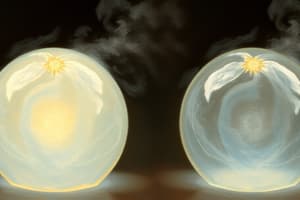Podcast
Questions and Answers
What occurs during an isothermal expansion?
What occurs during an isothermal expansion?
- The temperature of the system changes.
- The internal energy of the system decreases.
- The internal energy of the system increases.
- The internal energy of the system remains constant. (correct)
Which of the following is a type of energy transfer?
Which of the following is a type of energy transfer?
- Conduction and radiation
- Work and convection
- Internal energy and temperature
- Heat transfer and work (correct)
What is the equation for the work done by a system in an isothermal expansion?
What is the equation for the work done by a system in an isothermal expansion?
- W = nRT (V1 - V2)
- W = nRT (V2 - V1)
- W = nRT ln(V2/V1) (correct)
- W = nR (V2 - V1)
What is the first law of thermodynamics?
What is the first law of thermodynamics?
What is the equation for the change in internal energy of a system?
What is the equation for the change in internal energy of a system?
How many types of energy transfer are there?
How many types of energy transfer are there?
Flashcards are hidden until you start studying
Study Notes
Work and Internal Energy
Isothermal Expansion
- Isothermal expansion is a process where a system expands at a constant temperature.
- In an isothermal expansion, the system absorbs heat from the surroundings and does work on the surroundings.
- The internal energy (U) of the system remains constant, as the heat absorbed (Q) is equal to the work done (W) by the system:
- ΔU = Q - W = 0
- Q = W
- The work done by the system is given by:
- W = nRT ln(V2/V1)
- where n is the number of moles of gas, R is the gas constant, T is the temperature, and V1 and V2 are the initial and final volumes, respectively.
Energy Transfer
- Energy transfer occurs when energy is transferred from one system to another.
- There are two types of energy transfer:
- Heat transfer (Q): energy transfer due to a temperature difference between the system and its surroundings.
- Work (W): energy transfer due to a force applied to the system.
- The first law of thermodynamics states that energy cannot be created or destroyed, only converted from one form to another:
- ΔE = Q - W
- where ΔE is the change in internal energy of the system.
- Energy transfer can occur through various means, including:
- Conduction: direct contact between particles
- Convection: transfer of energy through fluid motion
- Radiation: transfer of energy through electromagnetic waves
Studying That Suits You
Use AI to generate personalized quizzes and flashcards to suit your learning preferences.




